......Drop me a comment and show me that you care.
Am I rambling to myself? I know a lot of this is written to clarify my own thoughts and so I can turn this into documentation later, but I'd love creative criticism, and even just silly questions and this will also help my thought process.
So, given the deathly silence so far, I'd like to know if anyone apart from me is reading this. Please drop a comment on this post if you are reading, but have found nothing to say about my previous posts.
Saturday, 28 October 2006
Drop me a comment and show me that you love me...
More German Dresses - Tapestries
Here are all the extant 12th C wall Hangings I can find so far. (The Bayeux Tapestry is probably late 11th C). Amazingly all of these are currently in one state of modern Germany - Saxon Anhalt. The manufacture of those than can be pinpointed is also attributed to this region.
Quedlinburg tapestry
Germany, late 12th Century (Quedlinburg Schlosskirche)
- Commissioned by Abbess Agnes who intended it for the pope
- Dodwell says some assumed it was a carpet because it was used to decorate the floor of the choir on feast days in 1600 and was used as a carpet in 1835, but that it really was a wall hanging
- Dodwell says this is a tapestry, I've seen claims elsewhere (craft magazines) this is the first carpet, complete with knot tied technique. I *think* Van Wilkens says it's knotted like a carpet, but it might still have been intended as a wall hanging.
- Quedlinberg is in saxon-anhalt, Germany. Sort of the east central bit. It's home to a convent founded by St Matilde in 936. It's not far from Hildesheim, a bigger monastic centre of the 12th C.
- There are more fragments than I have pictures of. According to Dodwell's descriptions there should be a few more female protagonists in the other portions.
- Tells the story of Mercury seeking a bride. He can't find anyone available amongst he immortals, so he finds a mortal girl Philologia. The other gods and goddesses decide to make her immortal.
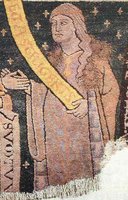
philiologia
- I think she's holding hands with Mercury and taking her marriage vows in this scene
- A fur lined cloak (with fur trim around neck?) conceals her left hand, her right hand has a maunche. We can't see the bottom of her dress
due to fraying of the tapestry - She wears a fine gold circlet over her loose hair

 "The concord of Church and State" Piety and Justice hug
"The concord of Church and State" Piety and Justice hug- Piety (left) looks like a male, but the 7 liberal arts are supposed to act as her maids in the story, so it must be a female (such short hair)
- Piety wears a dress with a collar and central vertical trim. The rest is obscured by her large mantle.
- Justice (right) wears a green dress that is calf length. Her dress is baggy the sides, so no side lacing. He sleeves are unusually fluidly drawn, and don't appear to be sitting comfortably.

"The concord of Church and State" Temperance
- This figure also looks a little male, but she's another liberal art, so must be female
- Garment is belted up at the waist, so that a white undergarment shows
- Garment is trimmed in byzantine fashion, with trim down centre front
- Sleeves appear to be short sleeves over tight undergarment. This sounds rather more byzantine male than female. But they could be long maunches tucked out of the way.
- It would be nice to see the other side - we might see long hair or sleeves on the other side.
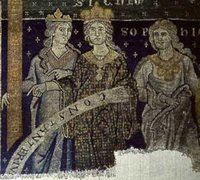 Mantice Psyche & Sophia
Mantice Psyche & Sophia- 3 Godesses depicted
- Mantice (left) has tightly fitting sleeves, or else sleeves that are hidden behind her dress (ie maunches unusually high on the sleeves). Her dress has a V neck.
- Psyche (centre) has a dress of patterned fabric with an interesting decoration at the bottom of her V neck. Her maunches are only medium length. Her undergarment (white or pale) shows not only at her cuffs, but also a small portion inside the v neckline of her dress. I think I can see a vertical line in the centre of this underlayer, that would correspond well with a keyhole neckline on the undergarment, but a better picture would be good.
- Sophia (right) Also has a strange elaboration of the trim at the bottom of her neckline. Her dress is drawn tight so we can see her ribs - it's probably side laced. Her sleeves are tricky to see, but I think she has maunches, but is twisting it around her arm, rather than letting it dangle (I've been known to play such when frustrated or bored). The vertical gold line on the border of the picture is in the right position to be trim on a maunche on her other arm.
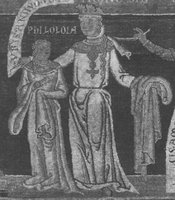 philogia & her mother (bringing her clothing and adornment)
philogia & her mother (bringing her clothing and adornment)- her more matronly mother has a full length dress (and is veiled). Her dress is tied in at the waist with a very fine belt. I think I can almost see belt mounts on it. Very fine belts like this are a more 13th C fashion. She also has some strange decoration on the front of her dress. We can't see maunches on her dress, but as that part of her arms are mostly concealed, the artist may have avoided clutter by showing fractions of maunches.
- Philiologia wears a full length dress with collar decoration and decoration on the cuffs of her underlayer. One of her sleeves looks like a classic maunche, if a bit more fluid than most, but the other is unusual - it covers her hand completely and then drapes down gracefully.
- It is probably fairly sensible to conclude both sleeves depict the same style in different configurations. In this case we may have a construction clue - maunches may be formed by making sleeves which are over long and somewhat bell shaped from the wrist. I personally don't think it would produce the exact style of maunche pictured, but it should produce something within the range of maunches we see.
Saxony, Mid to late 12th C
(Berlin, Schloss Charlottenburg, Kunstgewerbemuseum (88.470) )
- the dating depends who you ask- 1180-1200 (Schuette), 1160-1170 (Van Wilkens), 1160 (Dodwell). Dodwell is an art historian, Schuette and Van Wilkens are textile specialists rather than art historians, Van Wilken's work is more recent than Schuette.
- Schuette says that is is in chain stitch using coloured silks on coarse linen.
- Both agree it is probably from Halberstadt region. (which fits with the similarity to the others on this page). Dodwell just says it was from Saxony.
- Dodwell thinks it had 4 registers of which only the top 2 survive.
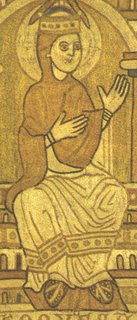 Pentecost
Pentecost- Mary wears the conservative veil/mantle/wrap combo.
- She wears lovely decorated shoes. There is an extant pair with brocaded tabletwoven bands in a pattern just like that from Phillip of Swabia's gravegoods (died 1208)
- you could interpret this as a decorative band a certain distance above the hem of a floor length dress, but the second picture with it's green dress (and white chemise/underdress below) argues against that.
- her mantle shows a different colour inside - could it be lined?
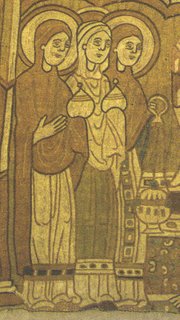 The holy women (three Marys) at the sepulchre
The holy women (three Marys) at the sepulchre- Also dressed conservatively as fits that kind of biblical figure.
- The middle Mary has a green dress, yet the under-layer is still pale. This still argues for an easy bleach linen layer. And since you already have one of those - the chemise, I don't see the necessity for a second.
- The Mary on the right has a vertical decorative strip of trim, as well as trim on her hem.
- It's interesting how they have their mantles tucked behind their ears. Easier to hear, but colder.
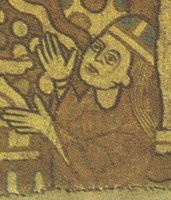
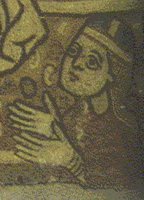
Female worshippers
- Dodwell also points out the female worshipper in the bottom right hand corner of each scene. Thanks muchly to his ghost, I had missed those!
- We can see one of those rather nifty caps, over loose flowing hair.
- I think her sleeves are flared, although it could be a mantle. She has tight fitting wrinkles white sleeve layers underneath.
Abraham tapestry
Halberstadt around 1150 (Halberstadt Cathedral Museum (Domschatz))
- bildindex has a high resolution b&w picture of the Abraham wall hanging.
- Bildindex says around 1160/1180, but is likely to be rather out of date
- Van Wilkens says it's 1065cm long, of colourful wool on white linen, and I think she says it's a true tapestry (rather than embroidery or carpet), but I'm not sure.
- The tapestry depicts Abraham receiving the angels, then taking Isaac to be sacrificed , spared at the last moment by a message delivered by another angel. The final scene is Michael slaying the dragon, which appears unrelated, but was likely there as a deliberate iconographic slant.
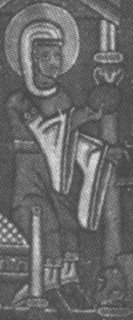 Abraham's wife Sara serving dinner to Abraham & angels
Abraham's wife Sara serving dinner to Abraham & angels- The most striking feature here are the sleeves. A different colour to the rest of the dress below a piece of trim on the bicep. I'll discuss that under the next picture.
- The dress is above the ankle with a white layer underneath showing below that point. The bottom hem of the dress is decorated with trim.
- The dress appears to be belted in at the high waist with a fat belt that sits horizontal (no french v-shapes). It could be a piece of trim instead of a belt, with a highly fitted dress instead. But the other pieces of trim have dots on them.
- There is something strange about her veil - looks like trim on the head edge? Maybe it's just a strange shadow, but there is still something unusual in the way it's drawn.
- A piece of trim on the bicep- only moderately common.
- no trim visible at the neckline. Her veil isn't that big to cover all of it.
 Abraham leading Isaac to be sacrificed
Abraham leading Isaac to be sacrificed- Abraham has the same colour difference between upper and lower sleeves, so his wife's sleeves weren't a fluke. I've seen this a couple of time before, but this is the first time I've thought this might be a real thing, rather than a misinterpretation. The other examples I've seen have been Victorian era copies of manuscripts (maybe the copyist made it up) or manuscripts (maybe one monk did the outline and another who had never seem women's fashion coloured it in). But as a tapestry, the person who 'coloured this in' was a worker in the textile industry. Their knowledge of tapestry associated textiles likely spilled over into noticing other textile related matter. Sure, it was probably the same monk who did the outline on the manuscript that did the outline on this tapestry, and it could have been woven by cloistered nuns, but I just find this more convincing. So if it's true to life, what could it represent?
- a garment with a seam at the bicep and a different colour sleeve below that. People have been arguing that the bicep bands of trim hide a seam for ages. There are plenty of counter arguments (it's imitating foreign fashion, other seams aren't covered by trim), but they are no stronger than the pro argument. There are a few writings about ladies giving sleeves as favours to their menfolk. Some have suggested these might be detachable sleeves (written descriptions are so vague), in which case it's just as easy to have a different colour as the same.
- <>a pale coloured garment with maunche sleeves and a dark coloured overgarment with short sleeves. We have elusive references to the french pelicon that is some kind of overgarment. It gets cold in winter, and extra layers really help. Extra chemises are great, but you can't take them off when it warms up or you move into a warmer room. Wearing two tunics is easier, but the sleeves do tend to get bulky. That's why surcoats become so popular, but they didn't take off for about 50 years after this. A short sleeved over garment is a good solution, if one we don't have much evidence for. It makes sense of the trim on the bicep - edging the overgarment.
 Crucifixtion scene, Middle Germany? 12th Century? (Pfarrkirche Sanct Katherinen, Salzwedel)
Crucifixtion scene, Middle Germany? 12th Century? (Pfarrkirche Sanct Katherinen, Salzwedel)I only know about this piece courtesy of bildindex. You can see the whole picture there. If anyone knows more about this, please let me know.
Salzwedel is in Saxon Anhalt and is known for its Baumkuchen. (cake on a spit - such a medieval style idea, but wikipedia says early 19th C).
The style of the artwork is the most removed of this group. It's a bit more angular I think. It could be from a different period - say a 14th C retro piece. The collar on the lady on the left says 12th C, but the shading on both dresses says it's much later. The hairstyles and way the shirt is being puled up (so typical in late 13thC, but executed differently when it rarely occurs in the 12th) look later too. If it's a 14th C piece that is deliberately copying an earlier style, that would explain the discrepancies.
So I'm not going to analyse the dress in this piece until I can get a more accurate date.
Fragment

 Halberstadt, middle of the 12th Century (Halberstadt Cathedral Museum (Domschatz))
Halberstadt, middle of the 12th Century (Halberstadt Cathedral Museum (Domschatz))I'm having trouble translating Van Wilken's ramble . I don't think this fragment is part of one of the other groups, but I'm not sure. Advanced German translation help welcome.
I think this one is knotted wool on linen (a "carpet"), rather than true tapestry.
Apostles Tapestry
1150-70 (Halberstadt Cathedral Museum (Domschatz))
- Dating varies - Dodwell says 1150-70, Van Wilkens 1170-75.
- there's a nice image of it on bildindex
- Van Wilkens says it's 927cm long, colourful wool on white linen, I think she says it's a true tapestry
- Depicts the apostles surrounding Jesus. No females here. (lets not discuss Mary Magdalen the apostle here)
Halberstadt, end of the 12th Century (Halberstadt Cathedral Museum (Domschatz))
- Van Wilkens says it measures 240x187cm, using colourful wool on white linen. I think it is a true tapestry.
- I'm sticking with Dodwell's dating here - museum labels are notoriously 50 years out of date.
- The one large fragment doesn't have any pictures of women, so it doesn't get a picture here. But it is very much in the style of the other wall hangings shown above (including the men's clothing), so I though it merited a mention.
- Bildindex has a black and white picture (or larger) that's about as good as any I've seen.
Labels: 12thC germanic dress, clothing
Wednesday, 18 October 2006
Aglets/points/chapes/laces
The other day, in typical me fashion, I told a friend about a technique I'd only read about (on a website and hadn't bookmarked) - making your own metal aglets.
Inspired by my confidence, we then foolishly proceeded to the local hardware store to buy metal sheets. Of course being a big chain they had nothing even close.
Anyway, I want to make amends now, (and wouldn't mind a metal aglet for myself), so here's the result of a short search.
supplies
My Dad, when asked, had some thin metal sheet he calls "scrimming" in his work van. It's very thin (sharp edges!) and looks like it's brass or some similar alloy. It bends easily in the hands and apparently cuts with scissors. This may even be too thin for our purposes, but he says it comes in a variety of weights. It's also a little corroded on the surface in some bits and shinny in others. I'm sure the corrosion will polish off, but it does let us know what the future of the piece will be.
Anyway, this metal sheet came from Blackwoods, whose website lists copper and brass metal sheeting down to 0.5mm and a few other varieties of things that look like metal sheets. But their website won't tell me how much the sheets cost. Annoying, but their 'metals office' is in Dandenong, so I guess I'll try in person If the test piece dad gave me works.
technique
'Ian' has an interesting website which considers modern methods of aglet repair. It's not what we want for the end of medieval laces, but I do find his list of different ways to make aglets interesting.
Marc Carlson (shoe guru) says that "Although they are not commonly found, medieval boot and shoe aglets seem to have been coiled brass wire, while those for clothing were wrapped metal sheets. " Interesting!
And of course I've seen a description somewhere lately - in the notes on lacing of the fingerloop CA. I'm not sure he doesn't make it more work than is needed though. I know they doesn't have good net access or a good library, so I suspect a lot of their work is based on what works, rather than what was done. Still it looks pretty close to what was done too.
Soper lane has an interesting article on the history of points/chapes/aglets, including mention of the chapemaker's guild. (So that's why both aglets and the end caps on scabbards are called chapes!). They say that aglets were generally copper alloys (brasses and bronzes) and riveted on with steel rivets (or crimped on post 1500), and finished with a file. Valuable information, but there's no instructions on how to make your own.
Dress Accessories says they excavated chapes from the mid 13th C to 15th C. "All of the excavated chapes are of copper-alloy sheeting, bent into tubes, with a straight seam along the side.Unless otherwise stated they are complete, tapering, and with an edge-to-edge seam, Several ends have been finished - that is, they seem to have been neatly bent inwards, perhaps by being rotated under pressure while held at an angle against a flat surface, and several others show faceting at one or both ends" (p281ff) It goes on to discuss what the facets might tell us about manufacture, but only says a few of the chapes had rivets (or rivet holes).
Here's an extant chape. It does look a lot like the ones in dress accessories, with no visible rivet hole. An another and another from the UK metal detector finds database - what a lovely site.
Some drawings of extant 'lace tags' (see numbers 16-22, and summary page 7) from Jedburgh Abbey, mostly 15th & 16th C. The site it comes from bears more investigation too - might be a treasure trove of archaeological reports.
And finally, just for reference- tying Elizabethan bows. Or this German version.
Well It's some interesting stuff I've found, but not the site I remember from a couple of years ago that was just what I wanted.
Special thanks to the friend who inspired me to look into this more (you know who you are). I've got some metal to play with now, let get together and experiment.
Labels: aglets
Monday, 9 October 2006
Cute Seal
 Seal-die of Isabella of Hainault
Seal-die of Isabella of Hainault
AD 1180-90, Paris
Courtesy of the British Library, who have a nice writeup accompanying this picture.
The shape, size and motif are typical for a 12th C female of that rank. I know because of a very interesting thesis-republished-as-book I read on the topic. Heavy reading, but you'll be fascinated with how much information about 12thC women she can infer from a statistically large sample of seals and charters.
What I find interesting about this picture is that it isn't one of the calf length dresses (if you look very carefully the layer of cloth with trim is probably her mantle dragged across her body, or at least I think so), but she probably has a horizontal band of trim at her waist. That's a feature almost less common than the calf length dresses.
Mostly I just wanted to show you the seal because it's so gorgeous (an extant seal!) and as a lesson in being careful. It took me a fortnight to realise this might not be a calf length dress.
Labels: clothing, french clothing
Sunday, 1 October 2006
More German Dresses - Henry the lion
Lets return to two of the pictures from my first post on German dresses, because they are such lovely artwork, and I've managed to find a few more pages.
I said last time before I knew that they were from the same workshop
- Helmarshauen is now a suburb of Bad Karlsruhe in central Germany (Hessen)
- Apparently the vertically elongated figures are to be expected due to the influence of the english Matilde, who became empress
This is all still true. Helmarhausen abbey was important centre of illumination, Duke Henry commissioned both these manuscripts and several others. The Gospel is considered the best work of this monastery.
Gospel of Henry the Lion
Helmarshausen. Gospels of Henry the Lion from Brunswich, MS Guelph 105 Noviss 2°, c1188 (Herzog August Bibliothek, Wolfenbüttel)
Whole page views online (don't forget to check next 3 pages).

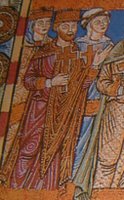

1st 3 images:
- A repeat of the one we saw earlier, but this time so we can see the style of another family member, in a green dress. Note trim at waist.
- Henry's relatives, one in blue has trim at waist and has the interesting headwrap that we've seen before. The other wears a mantle concealing everything (but what a pretty mantle).
- Matilde wears the longest sleeves of anyone, but we can't see many other details other than patterned fabric, because of her pretty fur lined mantle.

next image: fol 19 dedication image
- This is Matilde, Henry's english wife herself, richly dressed.
- her underlayer is a rich cream colour, although maybe the artist just wanted to differentiate it from the fur lining of her mantle.
- her sleeves are longer than anyone else's and have a white lining.



Next 3 images: fol 170v Crucifixtion
- Can't be sure middle figure is female, but long plaits suggest this.
- Being a crucifixtion scene the first figure, the only female saint present, has to be the mother Mary. The third figure might be a virtue (something about her posture) and the second could be likewise or could be the donor (Matilde), or I could have it all wrong.
- examples of full length dresses alongside patterned ones - probably do represent co-existant fashions, with the younger figure (hair out instead of veil) wearing the fancier fashion.
- Lots of gorgeously coloured veils
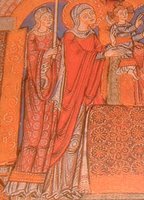

2 images: fol 111 presentation in the temple
- Mary (holding Jesus) wears a full length dress veil and wrap
- to the left of Mary, an attendant (might be a virtue) wears the fancier fashion with her hair uncovered
- the attendant's fabric is shown with rondell patterns - a popular design in fabrics of the time (especially expensive imported silks).
- A pilgrim saint (holding pilgrim's walking stick) watches, also dressed conservatively rather than fashionably

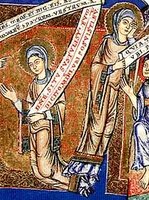
2 images: fol. 171r Mary meets the desciples, Jesus sends Mary to the desciples and Mary at the grave.
- This page is most comic book like - it's the adventures of Mary during the resurection, in reverse order.
- With the comic book theme, Mary is dressed almost identically in all pictures (her trim might change a little, but that's all). We can see the same costume in different postures.
- Her dress is belted up a little (see the sag line at her waist) presumably by a thin cord, since no belt shows
- This time she is not being presented very conservatively, but a little more loosely - she wears the fashions, but is veiled as a married woman is likely to be.
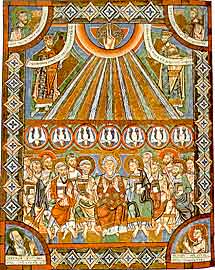
image details unknown
You can't see this page very well, because the original image is so small (if anyone has a better copy....), but you can see in the bottom centre a female saint, almost certainly the 'virgin' mary, and see that her tunic hem is higher than the white layer underneath.
Psalter of Henry the Lion
Psalter of Henry the Lion, MS Lansdowne 381 fol 8, Helmarshausen 1168/89 (British Library)
Can be found online courtesty of the British Library.

1st figure: fol. 7v Annunciation
- Will be Mary, since she's the only female present and this is the annunciation
- While she has a conservative wrap and veil, she has a shorter patterned dress
- She has fancy wrinkled chemise sleeves

2nd figure: fol 10v Mary at the Crucifixtion
- Again, a conservative wrap and veil, but a shorter dress, this time unpatterned. Perhaps this artist is tying to copy/match with the artist above (who seems better at clothing and detail, but worse at people and proportion)
 3rd figure: fol8v The presentation at the temple
3rd figure: fol8v The presentation at the temple- I've already shown you a black and white copy of this - but this is colour.
- An attendant to Mary, possibly a virtue, and dressed almost identically to the one in the gospel, except the colour at pattern of her tunic
- her tunic is in a cross style - another popular design we see in extant textiles
- The vertical trim could be a belt or it could be imitating byzantine styles, or it might be trim, but it looks a little awkward where it meets the base trim.
- Notice she might have a slight wrinkly sleeve syndrome happening. Interesting.
Comparison (because I can't help myself)
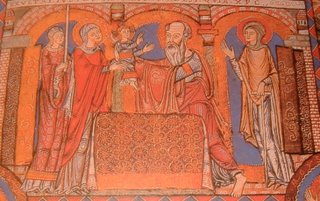

First image is from the gospel, the second the psalter. You can successfully play spot 11 differences here, but the artist has definately copied a successful scene from one to the other. His changes have probably been primarily concerned with colour and spacial balance, and accomodating appropriate thematic elements (the pilgrim saint only present in one). This is a nice example of how artists worked from models such as other manuscripts, but it also shows how much variability could be instilled into the same scene too. (I'll come back to this topic later when I get around to rambling about byzantine origins). The psalter (second picture) is probably the earlier one of the two.
